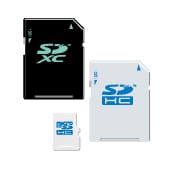As technology advances and requires faster data transfer speeds, adding PCIe® and NVMe™ architectures to SD memory cards delivers faster access to data files than the various legacy SD platforms. The huge increase in sequential and random access provided by PCIe/NVMe, the same interfaces used today by SSDs, enables new use cases of running applications and/or OS directly from cards.
In less than 25 minutes, product developers can gain a clear understanding of why and how to implement SD Express into their products by watching the following videos.
What Is SD Express and microSD Express?
SD Express delivers the high performance sequential and random access needed for evolving technology. Discover the incredible speed and performance potential of SD Express, first introduced in the SD 7.0 Specification, and microSD Express, introduced in the SD 7.1 Specification. These technologies were further enhanced by the SD 8.0 Specification. This video provides a comprehensive overview:
The SD 9.1 Specification brings key advancements, including SD Express Speed Classes and vital power and thermal management. This allows a common language between host, card developers and consumers to make sure that the application’s needs will be fulfilled while utilizing the proper cards, especially in cases where minimum performance needs to be assured. Learn about them here:
You may read and learn more about SD Express Speed Class performance features.
Exciting Applications for SD Express:
SD Express memory cards deliver SSD-level performance, making them ideal for a multitude of applications. These include:
- Drones
- Security cameras
- Automotive innovations
- Action cameras
- VR
- 4K/8K video
- 360-degree cameras
- Gaming
And much more!
How to Easily Add SD Express into Your Products
Given the possibilities unlocked by SD Express, it is not surprising that so many innovative leaders in the computing and storage industry have embraced this advancement. See a current list of companies producing SD Express products.
Upgrading to SD Express is simple. SD Express leverages well-known PCIe and NVMe architectures to deliver a significant upgrade in SD memory card performance while maintaining all the portability and convenience loved by consumers and businesses. This integration enables faster transfer speeds, simplifies development for manufacturers, and ensures broad compatibility.
With just a few minor additions to standard SD Host Controllers, you can unlock the incredible speed and performance of SD Express and deliver new capabilities for the company’s products. Check out this step-by-step guide:
Off-the-shelf solutions for adding SD Express features to any product are available from a variety of SDA members, including solutions for bridging, connectors and product testing. Explore more about these options by watching this video (you may skip directly to the off-the-shelf bridge solutions starting from time 2:38):
You may also review the slides presented in the SD Express Implementation webinar: Webinar: Solutions for Implementing SD Express into Your Products
Or even watch a video recording of this webinar here.
And last but not least – one of the features of SD Express cards is its ability to be initiated directly from its PCIe/NVMe interface using standard NVMe drivers. Hosts that prioritize the PCIe/NVMe interface and don’t require backwards compatibility with traditional SD cards can choose to implement a PCIe/NVMe-only interface. While these hosts may not be fully SD compliant, they can still support SD Express cards.
SD trademarks are owned and licensed by SD-3C LLC.
PCI Express® and PCIe® registered trademarks of PCI-SIG®.
NVM Express™ and NVMe™ are trademarks of NVM Express, Inc.
©2022 SD Association. All Rights Reserved.




